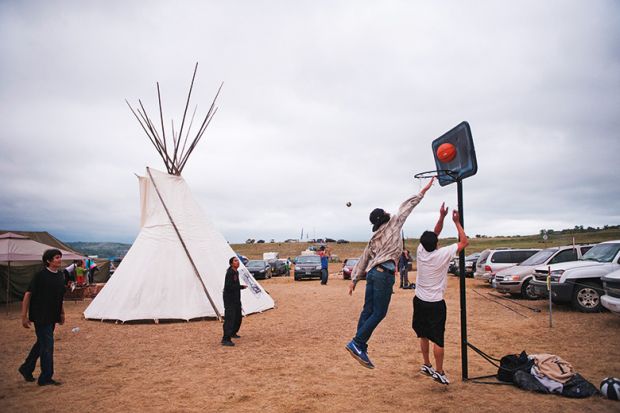Among the many institutions in North America that memorialise the native population is Miami University in Ohio, named after the Miami tribe that once spread from the state across vast sections of what is now the United States.
It is an ironic tribute considering the treatment of the Miami people, who were attacked by whites as the frontier pushed west, and whose lands were also taken.
Now, universities including Miami are in the vanguard of work to restore one of the principal cultural relics of indigenous tribes: their languages.
The efforts are made amid high-profile modern-day battles, from the contentious dispute over the names of professional sports teams, such as the Washington Redskins and Cleveland Indians, that many consider offensive, to the fight involving the Sioux tribe over the $3.8 billion (£3 billion) Dakota Access oil pipeline.
“There’s a heightened awareness and things are changing on the national level, especially with the recognition of the global loss of small minority languages and what that means to society as a whole,” said Daryl Baldwin, director of Miami University’s Myaamia Center, which offers courses on native culture and language.
“I would go as far as to say [that our] work is very much a healing process for the tribal community, to empower themselves and empower their youth,” said Mr Baldwin. “Tribes are having to rethink how their languages and cultures are going to survive in the modern world.”
What’s in it for the universities is more complicated. Miami University also called its sports teams the Redskins but changed the name to the RedHawks in 1997 in response to pushback from the tribe. While that debate was going on, the university offered scholarships to Miami tribe members. Those scholarships have risen from three per year in 1991 to 32 today.
Mr Baldwin, who was recently awarded a MacArthur Foundation fellowship – known as a “genius grant” – has co-authored research showing that students who learn their own language and culture graduate at higher rates than other Native American students.
“Part of the empowerment process is embedded in the revitalisation of language and culture, and those two things go together,” he said. Knowing their ancestral language, he said, means that students have “not only an increased awareness of their heritage, but a strong reconnection to each other. They bond, they develop a stronger sense of being connected to their tribal communities.”
North of the border, Canadian universities are expanding indigenous studies programmes in response to last year’s release of the report of the Truth and Reconciliation Commission that exposed what it called “cultural genocide” against indigenous Canadians.
The proportion of universities offering indigenous language courses rose from 44 per cent in 2013 to 54 per cent last year, according to Universities Canada, which says that now more than 30 different languages are being taught.
“There’s an awakening from many students who are craving to know their traditions, their customs,” said Joan Greyeyes, director of First Nations and Métis relations at the University of Saskatchewan, in Saskatoon. Métis are people of mixed French and native ancestry.
Welcoming a visitor in Cree to the university’s administration building, Ms Greyeyes said that her grandmother spoke French, English, Cree and Michif, the Métis dialect – four of the seven different languages spoken in the province of Saskatchewan.
The trouble is that understanding of these languages has declined. “We’re the last generation who are fluent speakers,” Ms Greyeyes said. It took the University of Saskatchewan two years to find a Cree speaker with a master’s degree who could teach a course in it, she said. The last fluent speakers of Myaamia are believed to have died in the mid-20th century.
So, new efforts by universities to preserve and revive these languages are focusing on training teachers. Saskatchewan, for instance, has followed the lead of the University of Victoria in British Columbia by launching a master’s programme that teaches how to revitalise indigenous languages. There are 17 students in the inaugural class, which will graduate in May 2018. Of those, 16 students are from Canada and one is from the US.
“We’re creating a pool of people for universities to hire,” Ms Greyeyes said. “They need to have these credentials for non-aboriginals to even listen to them. So now they’ll have that.”
One of the master’s candidates, Bob Badger, sees a more existential purpose for this work.
“Without language, we are empty vessels,” said Mr Badger, a member of the Kawacatoose tribe who is fluent in its native language, Saulteaux. “Within our languages, we have a deep understanding of the world around us. We make connections between the traditional cultural teachings and our place in the world. The language is alive and the language has a spirit.”
As for Ms Greyeyes, she has no doubt that native languages can be preserved.
“Our history is 6,000 years old,” she said. “No wonder they can’t get rid of it.”
POSTSCRIPT:
Print headline: Keeping North America’s indigenous languages alive
Register to continue
Why register?
- Registration is free and only takes a moment
- Once registered, you can read 3 articles a month
- Sign up for our newsletter
Subscribe
Or subscribe for unlimited access to:
- Unlimited access to news, views, insights & reviews
- Digital editions
- Digital access to THE’s university and college rankings analysis
Already registered or a current subscriber?




